Bane
Contents
The Origins
Bane is an old thing brought about by Malek, its practitioners known as Ferriers. The Mark was never intended to be wielded by mortal souls outside the god’s purview, developed by necessity as he studied the Dead Realm. Rather, Malek was pressed into calling upon the devout to combat unlife and the undying, and he made the mistake of imparting it upon a chosen few as a necessary tool. After all, it might have been the pox that could rot them from within, despoiling the courts of elves as a form of natural selection. It contained the seed of his malice, a fragmented precursor of what would later become the Black Sigil, and all that spoiled was sure to fester...
Yet Bane was not enough. The elves took that pestilence and turned it upon its maker, holding up that dripping pike to mock him as they carried on as they always had with so few of them succumbing to the seed withering their souls from within. Only then did Malek revisit the seed, creating the Black Sigil and thrusting it upon those who had lived too long. They would wither, in the end, but Bane still lives on as a reminder of the capriciousness of the races of Atharen.
Since its inception, Bane has been adopted by religious institutions the world over. Ferriers are seen as frightening shepherds of the dead, carrying the will of Malek or wielding scathing mockeries against him. No matter which side the Ferrier may take, there are many upon Atharen who would wish to have their soul ferried should they die, often earning them a quiet respect from the populace who require this vital service. Yet, they will still be quick to blame their ills upon them, and for good reason.
Concepts
Miasmata: Miasma is composed of the free spiritual particles that shape the Dead Realm, formed by the decay of ghosts and the scattering souls of non-sentient living beings. Miasmata is then the art of manipulating this phenomena, or interpreting it. There are three known types of Miasma.
- Ashes: By far the easiest form of miasma to work with, Ashes are the powdery essence that blankets the Dead Realm. These miasmic Ashes are everywhere, blanketing everything just beyond mortal perception. Highly malleable, yet limited, Ashes are typically charged, or inhaled and then exhaled.
- Pathos: When the body falls ill, a caustic miasma called Pathos naturally forms within the wound or suffering organ, shed from an ailing soul. In its natural state, Pathos is what leaves the body open to illness and infection, a sponge that soaks in disease and allows it to fester. Unnaturally, a Bane mage manifests artificial Pathos to cause harm upon others in the form of Banes. Unnatural Pathos has the quality of degrading and dissolving the Ethos of ghosts, burning their incorporeal forms.
- Ethos: Comprising ghosts or the decomposing silhouettes of soulless dead creatures, Ethos is an inflexible form of miasma containing information about the creature or person it once was. It also clings to objects of emotional importance to those deceased who have not yet passed on. Ferriers study Ethos to learn about the dead, by consequence learning of the secrets the living may wish to keep hidden.
Initiation
Threshold Sickness
The drawbacks listed below do not always come in pairs, and certainly not simultaneously. Some may come and others may not.
Lesser: Nausea, fatigue, headaches, muscle spasms, dehydration
Moderate: Bleeding through the nose, eyes and ears, intense cramps, seizure-like shocks and spasms, internal bleeding, vomiting and weakness
Severe:
Mutations
Abilities
x:
Scourge Abilities
x: x
Novice
Apprentice
Journeyman
Expert
Master
Ascension: The Scourge
x
